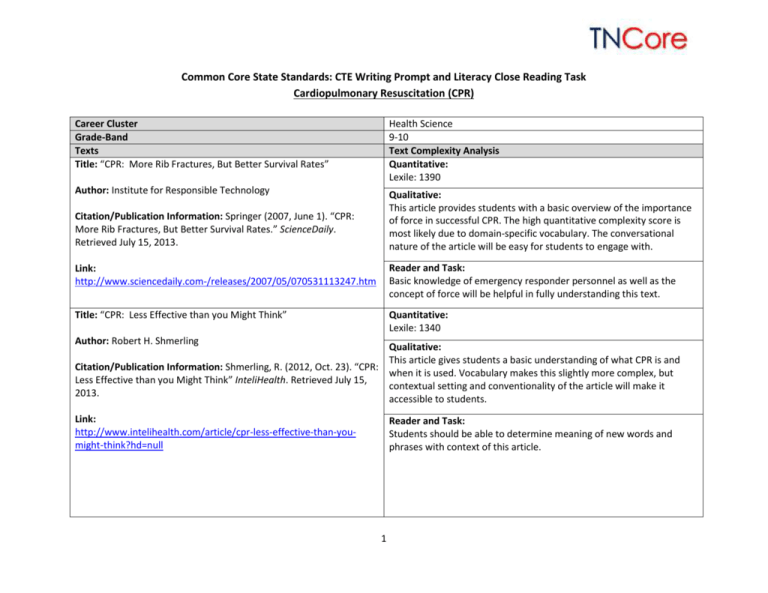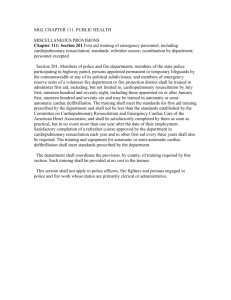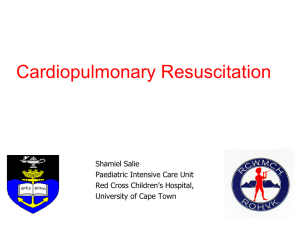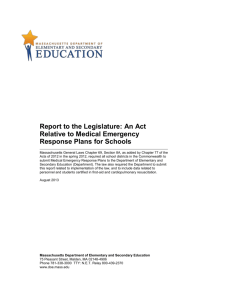Cardiopulmonary Resuscitation (CPR)
advertisement

Common Core State Standards: CTE Writing Prompt and Literacy Close Reading Task Cardiopulmonary Resuscitation (CPR) Career Cluster Grade-Band Texts Title: “CPR: More Rib Fractures, But Better Survival Rates” Health Science 9-10 Text Complexity Analysis Quantitative: Lexile: 1390 Author: Institute for Responsible Technology Qualitative: This article provides students with a basic overview of the importance of force in successful CPR. The high quantitative complexity score is most likely due to domain-specific vocabulary. The conversational nature of the article will be easy for students to engage with. Citation/Publication Information: Springer (2007, June 1). “CPR: More Rib Fractures, But Better Survival Rates.” ScienceDaily. Retrieved July 15, 2013. Link: http://www.sciencedaily.com-/releases/2007/05/070531113247.htm Reader and Task: Basic knowledge of emergency responder personnel as well as the concept of force will be helpful in fully understanding this text. Title: “CPR: Less Effective than you Might Think” Quantitative: Lexile: 1340 Author: Robert H. Shmerling Qualitative: This article gives students a basic understanding of what CPR is and Citation/Publication Information: Shmerling, R. (2012, Oct. 23). “CPR: when it is used. Vocabulary makes this slightly more complex, but Less Effective than you Might Think” InteliHealth. Retrieved July 15, contextual setting and conventionality of the article will make it 2013. accessible to students. Link: http://www.intelihealth.com/article/cpr-less-effective-than-youmight-think?hd=null Reader and Task: Students should be able to determine meaning of new words and phrases with context of this article. 1 Title: “Chest Compression–Only CPR by Lay Rescuers and Survival From Out-of-Hospital Cardiac Arrest” Quantitative: Lexile: 1530 Qualitative: Because of the domain-specific research vocabulary and intertextuality, this is a highly complex text. Author: Bentley J. Bobrow, MD; Daniel W. Spaite, MD; Robert A. Berg, MD; Uwe Stolz, PhD, MPH; Arthur B. Sanders, MD; Karl B. Kern, MD; Tyler F. Vadeboncoeur, MD; Lani L. Clark, BS; John V. Gallagher, MD; J. Stephan Stapczynski, MD; Frank LoVecchio, DO; Terry J. Mullins, MBA; Will O. Humble, MPH; Gordon A. Ewy, MD Reader and Task: We recommend using the tables in this article as a teaching tool for students to be able to translate information from charts into text. Complexity will be high for students unfamiliar with this skill. Citation/Publication Information: Bobrow, B, et al. (2010, Oct. 6) “Chest Compression–Only CPR by Lay Rescuers and Survival From Out-of-Hospital Cardiac Arrest.” The Journal of the American Medical Association. Retrieved July 15, 2013. Link: http://jama.jamanetwork.com/article.aspx?articleid=186668 Strand CCSS Reading for Technical Subjects: Key Ideas and Details CCSS Reading for Technical Subjects: Craft and Structure CCSS Reading for Technical Subjects: Integration of Knowledge and Ideas ELA/Literacy Common Core State Standards addressed by task* Grades 9-10 1. Cite specific textual evidence to support analysis of science and technical texts, attending to the precise details of explanations or descriptions. 2. Determine the central ideas or conclusions of a text; trace the text’s explanation or depiction of a complex process, phenomenon, or concept; provide an accurate summary of the text.* 4. Determine the meaning of symbols, key terms, and other domain-specific words and phrases as they are used in a specific scientific or technical context relevant to grades 9-10 texts and topics. 8. Assess the extent to which the reasoning and evidence in a text support the author’s claim or a recommendation for solving a scientific or technical problem.* 9. Compare and contrast findings presented in a text to those from other sources (including their own experiments), noting when the findings support or contradict previous explanations or accounts. 2 CCSS Writing for Technical Subjects: Text Types and Purposes CCSS Writing for Technical Subjects: Production and Distribution of Writing CCSS Writing for Technical Subjects: Research to Build and Present Knowledge Health Science Education Medical Therapeutics 1. Write arguments focused on discipline-specific content. a) Introduce precise claim(s), distinguish the claim(s) from alternate or opposing claims, and create an organization that establishes clear relationships among the claim(s), counterclaims, reasons, and evidence. b) Develop claim(s) and counterclaims fairly, supplying data and evidence for each while pointing out the strengths and limitations of both claims and counterclaims in a discipline-appropriate form and in a manner that anticipates the audience’s knowledge level and concerns. c) Use words, phrases and clauses to link the major sections of the text, create cohesion, and clarify the relationships between claim(s) and reasons, between reasons and evidence, and between claim(s) and counterclaims. d) Establish and maintain a formal style and objective tone while attending to the norms and conventions of the discipline in which they are writing. e) Provide a concluding statement or section that follows from or supports the argument presented. 4. Produce clear and coherent writing in which the development, organization, and style are appropriate to task, purpose, and audience. 5. Develop and strengthen writing as needed by planning, revising, editing, rewriting, or trying a new approach, focusing on addressing what is most significant for a specific purpose and audience.* 9. Draw evidence from informational texts to support analysis, reflection, and research. Tennessee CTE Standards addressed by task 1.0 The student will know and apply the academic subject matter required for entrance within the Health Science Career Cluster. 1.3 Use medical terminology, including root words, prefixes, suffixes, and abbreviations. 8.0 The student will perform skills necessary for physical assessment of health status and emergency care.* 8.2 Demonstrate cardiopulmonary resuscitation emergency procedures.* 3.2 Investigate the anatomy and physiology of the cardiopulmonary system. 3.4 Perform cardiopulmonary resuscitation incorporating correct usage of personal protective equipment.* * Standards noted with an asterisk (*) will only be covered if this activity is conducted as a longer-form lesson and writing task or in combination with technical skill development in a laboratory setting. Other standards may be covered and/or assessed through using this activity as an assessment or writing prompt. 3 What key insights should students take from these texts? 1. Cardiopulmonary resuscitation (CPR) includes chest compressions and rescue breathing. Different forms of CPR include different combinations of these practices. 2. Research has shown varying degrees of success of CPR techniques. 3. Specific challenges with CPR, such as the amount of force required for quality compressions, decrease the efficacy of the practice, especially if conducted by untrained personnel. 4. Success rate of CPR varies widely, based on many factors. Text-Dependent Questions 1. What are the factors that Dr. Shmerling outlines as important in the success rate of CPR? What evidence in the text does he give to explain why these factors are important? 2. What published studies, referenced in the texts, suggest changes to CPR to improve success rates? a. What are the changes they suggest and why? Writing Mode Writing Prompt Argumentative You are sitting in a health science class and your teacher informs you that starting next Monday, you will begin to learn Heartsaver Cardiopulmonary Resuscitation. Write an argument in which you answer the question: How effective is cardiopulmonary resuscitation? Begin by selecting one of the following claims or create your own. Cardiopulmonary resuscitation is highly effective and everyone should learn this skill. Cardiopulmonary resuscitation is not effective and should only be performed by healthcare professionals. Be sure to support your claim with multiple sources of scientific data and evidence from the texts provided. Include reasoning that builds a strong, compelling argument that will persuade your readers. Identify a counterclaim and include reasoning that would explain the strengths and limitations of this claim. 4 Discussion: These texts can be explored orally and used to form the basic foundation of a lesson or series of lessons. Lexile scores are slightly higher than grade-band recommendations because of advanced vocabulary and longer sentences; however, the conventionality and organization of these texts should allow comfortable access for students. Close-reading questions should be developed in advance in order to drive student understanding of the material while also practicing reading skills. For information on how to develop questions for this type of discussion, visit http://www.tncore.org/english_language_arts/curricular_resources/text_dependent_questions.aspx. Writing and/or Assessment: The writing prompt included can be either a constructed-response assessment or a longer-term writing assignment for students to develop and refine over time to gauge student understanding of Health Science content as well as reading and writing skills as outlined by the Common Core State Standards for English Language Arts in Technical Subjects. An appropriate writing rubric – such as those found at http://tncore.org/literacy_in_science_and_technology/assessment/scoring_resources.aspx – should be used to assess student work. Assessment: If using this material as an assessment, present all three texts to students at once, and provide them with the prompt and materials to use to construct their response. This should be a timed exercise (for example, 90 minutes). Use this exercise as an assessment to measure student progress toward reading and writing expectations as well as content knowledge. This is a good primer activity for state assessments. Task: If using this material as a writing task, you may scaffold the texts with close readings and text-based questions to guide student exploration of the text(s). A culminating task of this lesson or sequence of lessons could be the writing prompt – either assigned in class, as homework, or as a report that is drafted and refined over time to build writing skills. Scaffolding and support for special education students, English language learners, and struggling readers: Consider pre-teaching synonyms of difficult vocabulary words. Lower-level readers and ELL students can still be challenged without being overloaded with difficulty. This strategy can also be used to differentiate for stronger readers by introducing new, and more challenging, vocabulary. Struggling readers would also benefit from visual aids to illustrate many of the ideas presented. Pictures, diagrams, and charts alongside the text will go far to aide students as they dissect the article. Note: Social, ethnic, racial, religious, and gender bias is best determined at the local level where educators have in-depth knowledge of the culture and values of the community in which students live. TDOE asks local districts to review these materials for social, ethnic, racial, religious, and gender bias before use in local schools. 5







